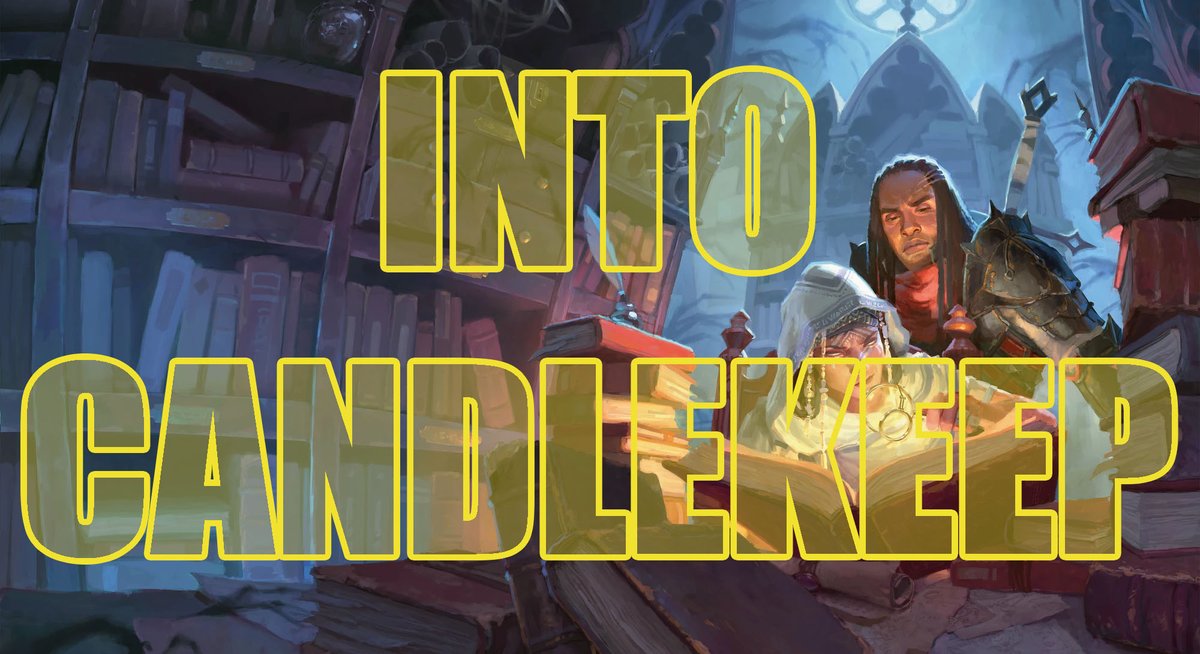
Today we're looking at "Mazfroth's Might Digressions" by Alison Huang.
This is a really nice, very tight scenario that demonstrates Huang's trademark style of layering complexity into her antagonists: The PCs are sent to investigate some criminals...
#CandlekeepMysteries
This is a really nice, very tight scenario that demonstrates Huang's trademark style of layering complexity into her antagonists: The PCs are sent to investigate some criminals...
#CandlekeepMysteries

...who are indirectly defrauding Candlekeep and putting people in danger.
But it turns out the criminals aren't aware of the true dangers of their actions & their motivations are closer to desperate altruism.
... until you take a still closer look and all the ethics turn murky.
But it turns out the criminals aren't aware of the true dangers of their actions & their motivations are closer to desperate altruism.
... until you take a still closer look and all the ethics turn murky.
This continues the #CandlekeepMysteries reaction thread that started over here.
https://twitter.com/hexcrawl/status/1373382006675972096
"Mazfroth's" also begins showing off some of the flexibility in the framing device for this adventure anthology: The first scenario brings the PCs to Candlekeep looking for a researcher and then adventuring in the library.
This scenario is triggered by the PCs coming to Candlekeep to do research and then venturing forth on adventure.
The hook here is that the PCs are attacked by a book that they're reading in Candlekeep. It turns out this is the third such incident, and when they investigate the trail leads them back to a bookseller in Baldur's Gate.
You could experiment with twisting this hook by having the book that comes alive and starts attacking people be the one which the PCs themselves have submitted to gain entry to Candlekeep!
You'd sacrifice some of the investigation (the PCs will know where they got the book from), but gain a potentially more compelling "you're responsible and need to fix it" dynamic instead of "you're the victim and need to seek redress."
In this format, you could imagine slotting this adventure opportunistically into #DescentIntoAvernus.
The PCs know they need to head to Candlekeep and that they need a book to gain entry, so they go looking and find one at the Amberdune Booksellers.
thealexandrian.net/wordpress/4451…
The PCs know they need to head to Candlekeep and that they need a book to gain entry, so they go looking and find one at the Amberdune Booksellers.
thealexandrian.net/wordpress/4451…
This would pull the PCs back to Baldur's Gate (presumably while Sylvira is researching the items they've brought her), which could be of benefit if they've shown interest in the evolving political landscape there.
Speaking of the investigation: There are three recent acquisitions at Candlekeep that have transformed and attacked their readers. Two of the donors are still at library and are detailed in the adventure. The third has already left... and is not described in the adventure at all.
This feels like something got cut for space, but without the ragged edges getting trimmed up. It's pretty easy for me to imagine a group becoming convinced that this "mysterious" third donor who has "conveniently" disappeared is the source of the problem!
I'd either want to figure out who this donor was or cut them entirely (and just have two books that have gone rogue).
Skipping ahead to the end of the adventure, Huang makes a good effort to make the Amberdune hangout a dynamic environment. 

But she's actually fighting the richness of the scenario: There's at least three radically different circumstances in which the PCs might come here, each logically calling for a different arrangement and reaction from the Amberdunes.
This is the sort of thing that calls out for an adversary roster.
thealexandrian.net/wordpress/3854…
thealexandrian.net/wordpress/3854…
Although with an environment as small as the Amberdune hangout, the distinction between an adversary roster and "list of people who live here" is pretty small. 

Either way, you're probably better off clearly presenting the toys, giving a paragraph of general guidance on each broad set of circumstances, and then letting the GM actively play in response to the PCs.
Rather than trying to pre-program the interactions.
Rather than trying to pre-program the interactions.
On p. 34 we have another section of The Advenure Plays Itself, this time in the form of, "If the PCs can't solve the mystery, just roll dice & tell them the solution."
This doesn't bode well for how the book is going to handle the Mystery in its title. But we'll see how it goes.
This doesn't bode well for how the book is going to handle the Mystery in its title. But we'll see how it goes.

Quoth the raven, "Twittermore."
The reaction thread continues with BOOK OF RAVENS by Christopher Perkins.
The reaction thread continues with BOOK OF RAVENS by Christopher Perkins.
https://twitter.com/hexcrawl/status/1374411209735245839
• • •
Missing some Tweet in this thread? You can try to
force a refresh








